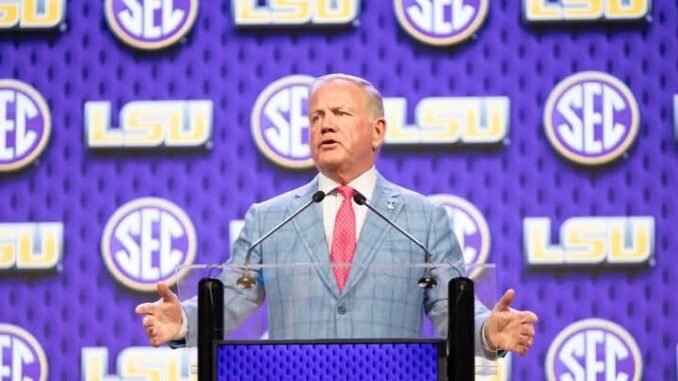
“LSU Football Unleashes a Jaw‑Dropping $13 Million NIL Blitz: Inside Brian Kelly’s Bold Playbook to Dominate Transfer Market, Retain Elite Talent, and Rewrite the College Football Rulebook”
In a bold display of strategic acumen, LSU head coach Brian Kelly has initiated a game‑changing investment in the Name, Image, and Likeness (NIL) sphere—deploying a staggering $13 million specifically frontloaded into NIL contracts for the 2025 roster. This isn’t just about flashy numbers; it represents a seismic shift in how elite college football programs arm themselves to recruit, retain, and recharge team rosters in an arms race dominated by financial firepower.
1. The Money Play: What Exactly is “Front‑Loading $13 Million”?
Speaking candidly to Yahoo Sports, Kelly revealed that LSU is “frontloading at a level where we are trying to get to or above $13 million,” distributing roughly $10 million of it to the 2025 roster before the July 1 NCAA NIL “cap” deadline . To put that in perspective, this is more than the total distributed over the previous three seasons combined: $5.5 m in 2024, $4 m in 2023, and $2 m in 2022 .
What that means: LSU can make early, high-impact financial offers to recruits and current players, strengthening their ability to retain existing talent and poach portal standouts with serious credibility. Kelly explained it plainly: “If Miami wants to give our third-stringer $1 million, good luck to them” .
—
2. Strategic Origins: How a Recruiting Loss Became a Trigger
The catalyst for this infusion? LSU’s shock defeat in the battle for Bryce Underwood—the nation’s top quarterback recruit. Initially committed to the Tigers, Underwood ultimately signed with Michigan after being swayed by an estimated $10–12 million NIL package .
Despite the sting, Underwood’s departure spurred a decisive response: according to On3, LSU’s NIL budget doubling to over $18 million following that loss—a move that has helped secure a No. 1 transfer portal class and set up a potent recruiting cycle . The Tigers used that financial momentum to rebuild — transforming adversity into action.
—
3. A Multi‑Front NIL Strategy: Beyond Just the Big Checks
Kelly’s approach isn’t singularly focused on paychecks. According to The Advocate, LSU rolled out a comprehensive NIL strategy encompassing financial literacy, group licensing, and grassroots supporter involvement .
Graduated, walk-on, and star alike all benefit:
NIL financial education to manage royalties, taxes, and earnings.
Group licensing initiatives—like NFTs, trading cards, and video game promos—to create alternative income streams .
Community engagement efforts, including service events tied to NIL earnings .
One standout: the Bayou Traditions digital subscription club, targeting $50,000 per month by offering fan perks including access to LSU content and athletes .
—
4. Coach Kelly’s Personal Investment & Fan Response
Brian Kelly and his wife Paqui aren’t just coordinating this blitz—they’re putting their own money behind it. Their “Kelly Family Million Match Challenge” pledged to match fans’ NIL donations dollar-for-dollar up to $1 million .
Thanks to generous grassroots contributions and an anonymous donor, that campaign raised around $3.23 million, with $2.23 million funneled directly into Bayou Traditions . This crowdfunding surge signaled a broad base of public support matched by high-level donor engagement—putting LSU in more competitive shape ahead of the transfer window .
—
5. Results: Elite Portal Class, Upgrading the Roster
Already, the impact is being felt. LSU heads into 2025 with the top transfer portal haul, starting with 13 new commitments in just two weeks—highlighting the recruiting success driven by NIL horsepower . And On3 confirms early 2026 recruiting looks equally impressive, with at least six 4-star commits—including five for that same class .
Kelly:
> “You can track a freshman who is going to be your third‑stringer… If he’s getting offered $1 million to transfer, there’s nothing to talk about.”
This investment strategy is helping LSU retake its footing in the national elite conversation, after missing out on College Football Playoff contention.
—
6. Broader Context: College Football’s New Financial Era
LSU’s NIL escalation reflects a wider transformation in college recruiting. Long gone are the days when coaching pitches focused solely on facilities, academics, or tradition .
Today, six- and seven-figure NIL deals are now standard for top recruits . Even coach Saban admitted Alabama athletes garnered $3 million from NIL last year . Kelly, meanwhile, emphasizes the importance of regulation—“I want to equalize our locker room” —while warning that recruitment shouldn’t become a bidding war.
Yet as other programs—Michigan, Texas, Ohio State—pour tens of millions into NIL, LSU’s $13 million plus household and fan-led campaigns show they’re committed to staying competitive .
—
7. What’s Next? The Stakes for 2025 and Beyond
July 1 “cap” deadline looms as LSU aims to frontload the full $10 million by then.
Transfer and early enrollee windows open and the Tigers want to maintain momentum.
Financial transparency and NCAA oversight will increase nationwide, meaning LSU’s mix of donor—and possibly coach—matched funding must comply .
Kelly’s vision: recruit hard, retain even harder, and sustain a roster capable of national contention without sacrificing academic or program integrity.
—
Conclusion: A Whole New Playbook
LSU’s $13 million NIL investment marks a defining moment in modern college football—a fusion of strategy, finance, and fan energy executed under Coach Kelly’s watchful eye.
It redefines how top programs recruit, retain, and team-build
It hinges on comprehensive educational and structural initiatives
It’s grounded in fan-backed momentum and coach-initiated giving
And it uncovers a fundamental truth: college football today is as much about financial strategy as on-field schematics.
As the 2025 season approaches, LSU isn’t just competing on paper—they’re arming themselves with the resources to win in every arena: field, locker room, negotiating table—and beyond.
Leave a Reply